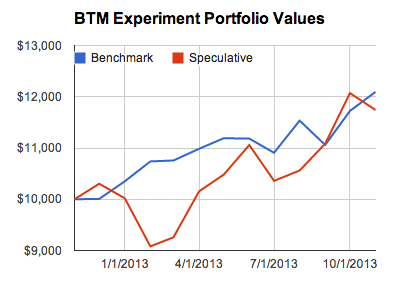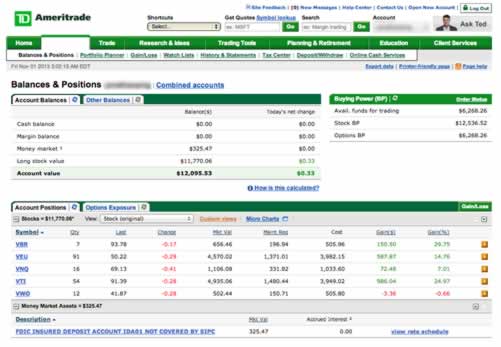It’s finally been a full year since starting my Beat the Market Experiment, a series of three portfolios started on November 1st, 2012:
- $10,000 Passive Benchmark Portfolio that would serve as both a performance benchmark and an real-world, low-cost portfolio that would be easy to replicate and maintain for DIY investors.
- $10,000 Beat-the-Benchmark Speculative Portfolio that would simply represent the attempts of an “average guy” who is not a financial professional and gets his news from mainstream sources to get the best overall returns possible.
- $10,000 P2P Consumer Lending Speculative Portfolio – Split evenly between LendingClub and Prosper, this portfolio is designed to test out the alternative investment class of person-to-person loans. The goal is again to beat the benchmark by setting a target return of 8-10% net of defaults.
I’m splitting this summary up: Part 1 will focus on the Benchmark vs. Beat-the-Benchmark results. Part 2 will include the P2P lending performance. Values given are as of November 1, 2013.
$10,000 Benchmark Portfolio. I initially put $10,000 into index funds at TD Ameritrade due to their 100 commission-free ETF program that includes free trades on the most popular low-cost, index ETFs from Vanguard and iShares. With no minimum balance requirement, no maintenance fees, and no annual fees, I haven’t paid a single fee yet on this account. The portfolio used an asset allocation model based on a David Swensen model portfolio, which I bought and held through the entire yearlong period.
The total portfolio value after one year was $12,095, up 21%. Here’s how each separate asset class fared from November 1st, 2012 to November 1st, 2013 (excluding dividends):
- Total US Stocks +$986 (+25%)
- Total International Stocks +$588 (+15%)
- US Small Cap Stocks +$150 (+30%)
- Emerging Markets Stocks -$3 (-1%)
- US REIT +$72 (+7%)
Screenshot of holdings below:
$10,000 Speculative Portfolio. Many people speculate with their money, buying and selling stocks now and then, but they rarely track their performance even though they may brag about their winners. Honest, regular tracking is the primary reason for this “no-rules, just make money” account. I dropped $10,000 into a TradeKing account for this portfolio due to their low-cost $4.95 trade structure, free tax-management gain/loss software, and free dividend reinvestment.
The total portfolio value after one year was $11,742, up 17.4%. Here’s how my individual positions fared (excluding dividends):
- Wisdom Tree Emerging Market Equity Income ETF +$175 (sold)
- Apple -$583 (sold)
- Enphase Energy +$1,874 (still open)
- Unitedhealth Group +$77 (still open)
Screenshot of current holdings:
Here’s a chart tracking the total portfolio values over the past year, updated monthly:

Year-end Thoughts
- In terms of picking stocks, my heart really wasn’t in it. I made much fewer trades than I was planning. There was just too much other stuff in my life I’d rather be doing than researching individual companies. I did find it interesting that both portfolios ended up with similar returns even though most of my stock-picking return was just due to one single stock pick.
- However, it was still good to have a real-money sandbox. From time to time, I know that I will have an urge to make a bet on a stock or two, and I think it is good to have a fun money account. I’m glad I bought my AAPL shares, took my chances, and lost money just as I am happy my ENPH shares went up 100%. I also like having a defined amount, like setting a budget before going to Vegas.
- I understand the urge to closet index. Professional portfolio managers don’t really care about absolute returns (even if they say they do). They care about returns relative to the market, because that is what their clients care about. If you lose 10% but the overall market also loses 10%, nobody will blame you. But if you gain 10% but yet the market went up 20%, your assets under management will probably shrink. As I often had a large cash position, I wondered if I should buy a S&P 500 index ETF so that up or down, I’d stay at least close to my benchmark portfolio. As it was, the S&P 500 shot up this year and my cash position held back my performance.
- New dividend-investing experiment? I might continue this experiment, but I’m leaning towards shutting it down (might wait for ENPH to become long-term gain). I was thinking that next I’d like to run a portfolio of say 10 dividend stocks and compare it to a popular dividend index ETF.


 The Best Credit Card Bonus Offers – 2025
The Best Credit Card Bonus Offers – 2025 Big List of Free Stocks from Brokerage Apps
Big List of Free Stocks from Brokerage Apps Best Interest Rates on Cash - 2025
Best Interest Rates on Cash - 2025 Free Credit Scores x 3 + Free Credit Monitoring
Free Credit Scores x 3 + Free Credit Monitoring Best No Fee 0% APR Balance Transfer Offers
Best No Fee 0% APR Balance Transfer Offers Little-Known Cellular Data Plans That Can Save Big Money
Little-Known Cellular Data Plans That Can Save Big Money How To Haggle Your Cable or Direct TV Bill
How To Haggle Your Cable or Direct TV Bill Big List of Free Consumer Data Reports (Credit, Rent, Work)
Big List of Free Consumer Data Reports (Credit, Rent, Work)
Hi Jonathan,
You might this article from SA interesting regarding dividends:
http://seekingalpha.com/article/1831062-dividend-growth-showdown?source=email_investing_income&ifp=0
How often do you rebalance the benchmark portfolio? Do you always do it at a specific time of the year?
I’ve followed your blog sporadically for years, and I’ve heard quite a bit from you. Thanks!
You don’t have to track your portfolio to be sure that you are beating the market:
Just use your benchmark ETF portfolio as collateral for a margin loan…if the loan balance is bigger than your “speculative” portfolio then you know you’ve beat the market and if it’s smaller than you know you haven’t.
This way you don’t even need regular price updates for your individual investments (much less the entire portfolio) and it’s so easy even you could do it with your half-hearted performance-tracked stock picking (even though wasting your brain tracking performance instead of thinking outside the box is exactly what’s holding you back)!
@TripK – Thanks for the link, it is an interesting read. It’s always seems harder to beat ETFs when you actually track everything closely.
@In the Wings – I rebalance using new funds continuously throughout the year (from our income) and also once a year unless there is some crazy market movement. I don’t do it at a specific time, although sometimes I think I should.
@ajohnymous – Neat idea. Not too exciting to pay the the margin interest though.
The David Swensen model portfolio that you reference seems to include bonds and inflation protected securities. However I don’t see those asset classes in your portfolio. Is there a reason for that?
Also do you automatically reinvest dividends from the ETFs or do ETFs not have dividends?
Thanks!
@In The Wings – Yes, but I stuck to 100% stocks for this experiment for both simplicity and lower trading costs (less trades) since I was just putting in $10,000. Ideally my stock-picking portfolio would also be 100% investing in stocks. I do hold both bonds and TIPS in my regular portfolio.
Yes ETF can have dividends. I chose not to automatically reinvest dividends in order to simplify taxes (fewer tax lots) and I would just rebalance once a year.